
Alternanthera is a genus of flowering plants in the family Amaranthaceae. It is a widespread genus with most species occurring in the tropical Americas, and others in Asia, Africa, and Australia. Plants of the genus may be known generally as joyweeds, or Joseph's coat. Several species are notorious noxious weeds.
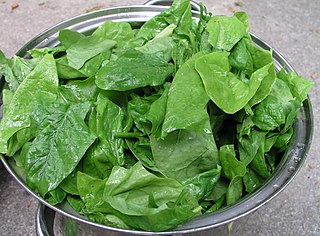
Leaf vegetables, also called leafy greens, salad greens, pot herbs, vegetable greens, or simply greens, are plant leaves eaten as a vegetable, sometimes accompanied by tender petioles and shoots. Although they come from a very wide variety of plants, most share a great deal with other leaf vegetables in nutrition and cooking methods.

Basella alba is an edible perennial vine in the family Basellaceae. It is found in tropical Asia and Africa where it is widely used as a leaf vegetable. It is native to the Indian subcontinent, Southeast Asia and New Guinea. It is reportedly naturalized in China, tropical Africa, Brazil, Belize, Colombia, the West Indies, Fiji and French Polynesia.
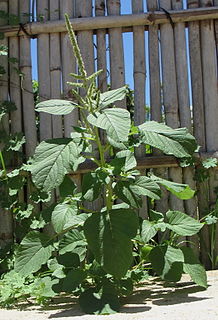
Amaranthus blitum, commonly called purple amaranth or Guernsey pigweed, is an annual plant species in the economically important plant family Amaranthaceae.

Crassocephalum rubens, also called Yoruba bologi, is an erect annual herb growing up to 80 cm tall. It is grown and consumed especially in Southwestern Nigeria, but also as far away as Yemen, South Africa, and islands of the Indian Ocean. Its mucilaginous leaves are used as a dry or fresh vegetable in a variety of dishes, and as medicine for several different ailments.
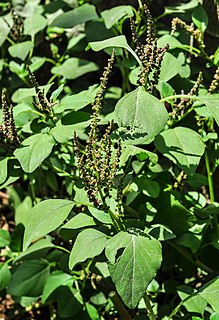
Amaranthus viridis is a cosmopolitan species in the botanical family Amaranthaceae and is commonly known as slender amaranth or green amaranth.

Amaranthus tricolor, known as edible amaranth, is a species of flowering plant in the genus Amaranthus, part of the family Amaranthaceae.
Amaranthus thunbergii, commonly known as Thunberg's amaranthus or Thunberg's pigweed, is found in Africa.

Amaranthus dubius, the red spinach, Chinese spinach,, spleen amaranth, hon-toi-moi, yin choy, hsien tsai, or Arai keerai is a plant species. It belongs to the economically important family Amaranthaceae.

Celosia trigyna is a plant species commonly known as woolflower for its curious flowers.
Acalypha bipartita is a species in the botanical family Euphorbiaceae. It occurs widely in Africa where it is eaten as a vegetable, or fed to animals. The leaves are considered nutritious, as they contain a high concentration of calcium. It is often found as undergrowth in the forest, on the edges of the forest, and in wooded grasslands, particularly in Sudan, Uganda, Kenya, eastern Zaire, Burundi, Rwanda, and Tanzania. The stems are often used in making baskets.

Alepidea peduncularis is an edible perennial herb native to the montane grasslands of East and South Africa.

Alternanthera sessilis is an aquatic plant known by several common names, including Matikaduri (মাতিকাদুৰী) in Assamese, ponnanganni, ponnaganti aaku, honnagone, mukunuwenna, sessile joyweed and dwarf copperleaf. It is used as a vegetable specially in Sri Lanka and some Asian countries.
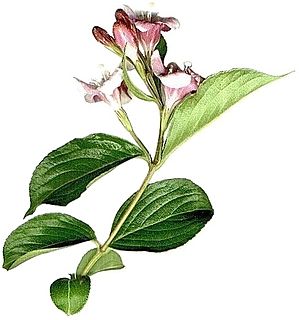
Barleria obtusa, the bush violet, occurs naturally along forest margins in the summer rainfall region of South Africa. It is widely cultivated as a decorative garden shrub.
Astragalus atropilosulus is a perennial herb in the legume family. It is native to Africa.

Asystasia mysorensis is an edible plant species in the family Acanthaceae found in Africa. It is used as a leafy vegetable and for animal fodder.
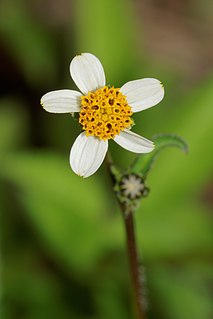
Bidens pilosa is an annual species of herbaceous flowering plant in the daisy family Asteraceae. Its many common names include black-jack, beggarticks, farmer’s friends and Spanish needle, but most commonly referred to as cobblers pegs. It is native to the Americas but is widely distributed as an introduced species in other regions worldwide including Eurasia, Africa, Australia, South America and the Pacific Islands.
Caylusea abyssinica is a plant species found in East Africa.

Spodoptera littoralis, also referred to as the African cotton leafworm or Egyptian cotton leafworm or Mediterranean brocade, is a species of moth in the family Noctuidae. S. littoralis is found widely in Africa, Mediterranean Europe and Middle Eastern countries. It is a highly polyphagous organism that is a pest of many cultivated plants and crops. As a result, this species was assigned the label of A2 quarantine pest by the EPPO and was cautioned as a highly invasive species in the United States. The devastating impacts caused by these pests have led to the development of both biological and chemical control methods. This moth is often confused with Spodoptera litura.
Sissoo spinach, also known as "Brazilian spinach", "Bayam Brazil", "Sambu", and "Samba lettuce", is a tropical edible groundcover of the genus Alternanthera used as a leaf vegetable. Although it is referred to scientifically as Alternanthera sissoohort., there are no known scientific descriptions of its taxonomy.















